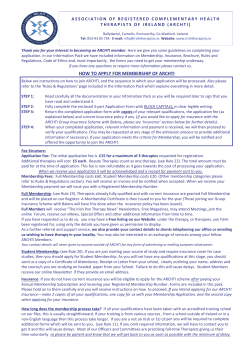
What is a Physical Therapist?
What is a Physical Therapist? Physical therapists are health care professionals who maintain, restore, and improve movement, activity, and health enabling individuals of all ages to have optimal functioning and quality of life. Additionally, pursuing exercise programs designed by a physical therapist has been associated with protecting patients against injury and potentially eliminating the need for surgery. Demonstrated Value Physical therapists are a highly effective alternative to prescription medication and surgery for many conditions.1 PTs commonly work with patients to alleviate pain correlated with the neck, shoulders, lower back, and knees, ailments affecting many Americans.2 Research shows that individuals who receive regular physical therapy treatment experience greater improvement in function and decreased pain intensity.3 Physical therapists, within their scope of practice, are extensively qualified to execute comprehensive patient care including examination, diagnosis, and treatment. In addition to mitigating pain from musculoskeletal conditions, physical therapists provide value for patients suffering from arthritis, vertigo, breast cancer, diabetic ulcers, and type 2 diabetes, among other conditions. Additionally, physical therapists have an extremely low incidence of liability claims. According to the Healthcare Providers Service Organization (HPSO), only 1,464 malpractice claims were issued involving physical therapists in the United States throughout a 13-year period.4 This low claims trend applies both to states that allow patients to have direct access to physical therapist services without a referral from a physician and the few states that do not. Cost-effective Care Studies indicate that early and appropriate access to physical therapy results in significant cost savings for employers, insurers, and patients.5,6 For example, physical therapy Holmgren T, Björnsson Hallgren H, Oberg B, Adolfsson L, Johansson K. Effect of specific exercise strategy on need for surgery in patients with subacromial impingement syndrome: randomised controlled study. BMJ. 2012. Feb 20;344:e787. doi: 10.1136/bmj.e787. 2 Fritz JM, Cleland JA, Speckman M, Brennan G, Hunter SJ. Physical therapy for acute low back pain: associations with subsequent healthcare costs. Spine. 2008;33(16):1800-1805. 3 Ibid. 4 Healthcare Service Providers Service Organization. Case Study with Risk Management Strategies. Physical Therapists and Medical Malpractice. 2011: n. page. Print. 5 Blackmore CC, Mecklenburg RS, Kaplan GS. At Virginia Mason, collaboration among providers, employers, and health plans to transform care cut costs and improved quality. Health Affairs. 2011:30(9):1680–1687. 6 Ehrmann-Feldman D, Rossignol M, Abenhaim L, Gobeille. Physician referral to physical 1 combined with comprehensive medical care may replace the need for surgery for those with moderate to severe osteoarthritis of the knee by relieving pain and stiffness.7 The American Heart Association encourages patients with heart disease to see a physical therapist for the initial treatment of pain as an alternative to prescription medications.8 Due to physical therapy’s categorization as a “specialty” health service, patients’ copayment responsibilities may be as high as $75 per visit, which can exceed the total cost of services. These patients seeking physical therapy may pay over $600 per month in out-of-pocket expenses, in addition to their monthly premium, to access essential treatment. Patients who fail to receive the rehabilitation care they need from physical therapists may be more likely to require higher-cost interventions to remain functional. Additionally, insurers avoid covering the cost of physical therapy care by limiting the total annual payment or by restricting the number of patient visits per year, per episode, or per condition. Increasing Access to Physical Therapy Despite the fact that most states allow some form of direct access to physical therapy, some patients experience barriers to care. Referral mandates by payers have been reported to cause delays in necessary patient treatment.9 Additionally, exorbitant copays and limited insurance coverage restrict the frequency and duration of care a patient can afford, often preventing patient compliance with professional recommendations. States that allow patients direct access to physical therapy services experience valuable cost savings. A study published ahead of print September 23, 2011, in the journal Health Services Research (HSR), reviewed 62,707 episodes of physical therapy in Iowa and South Dakota. These states have allowed direct consumer access to physical therapists for more than 20 years. The researchers used non-Medicare claims data from a Midwest insurer over a 5-year period to validate cost savings. While earlier research also supports cost savings with direct consumer access, the HSR study is the most comprehensive to date for having incorporated an extensive number of episodes and controlling for illness severity and other factors that could affect patient outcomes. therapy in a cohort of workers compensated for low back pain. Phys Ther. 1996;76(2):150-157. 7 Kirkley A, Birmingham, TB, Litchfield RB, et al. A randomized trial of arthroscopic surgery for osteoarthritis of the knee. NEJM. 2008;359:1097-1107. 8 Elliott MA, Bennett JS, Daugherty A, Furberg C, Roberts H, Taubert KA. Use of nonsteroidal antiinflammatory drugs: An update for clinicians: ascientifit statement from the American Heart Association. Circulation. 2007:115:1634-1642. 9 Pinnington MA, Miller J, Stanley I. An evaluation of prompt access to physiotherapy in the management of low back pain in primary care. Fam Pract. 2004 Aug;21(4):372-80. The 2011 HSR survey reported several findings that explicitly support direct access and physical therapy intervention. Of the most notable conclusions, researchers found that the average cost for physical therapy claims was lower for patients who visited a physical therapist directly ($347) than for patients referred by a physician ($420). Additionally, patients who visited a physical therapist directly for outpatient care had 86% fewer visits on average than those who were referred by a physician. Moreover, direct access to physical therapy did not correlate with overuse or decreased quality of care, or with patients’ disengagement from the overall health care system. In contrast, the study found that delays in care result in higher costs as untreated conditions may require more expensive treatment. Additional consequences of limited access include decreased functional outcomes and frustration among patients requiring physical therapy services. Conclusion The benefits of physical therapy are extensive, enabling patients to live healthily while avoiding unnecessary surgery, medication, and doctor’s visits, which often impose a heavy financial burden. However, the current health care system prevents physical therapists from providing necessary medical treatment to patients as a result of unfair copays and limited access. Policy reform is necessary as a proactive response to addressing systemic inefficiencies impeding patient access to high-quality care. Specifically, reform supporting direct access will enable patients to access physical therapy without an outside referral, thereby providing for timely and cost-effective fulfillment of valuable medical treatment. Payment reform aims to restructure the current copay system to withdraw physical therapy from a category of “medical specialists” charged on a per visit basis, to ease the financial burden on patients and employers. This act operates in compliance with the Patient Protection and Affordable Care Act, which will limit individuals’ annual deductible for health care coverage to a maximum of $2,000 effective January 2014. Physical therapy is a medically necessary component of comprehensive health care services for citizens. State and federal policy reform is vital to providing unrestrained access to high-quality care, which will reduce lost time and finances expended by patients and employers.
© Copyright 2025





















